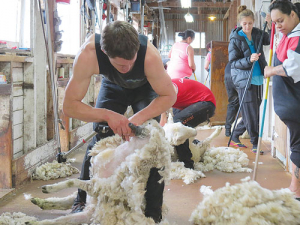Industry funded studies in New Zealand have shown that mid-pregnancy shearing can increase multiple-born lamb birthweight by up to 0.7 kg and lamb survival by 3 to 5%.
In those individual studies, ewes were shorn as early as day 50 of pregnancy and as late as day 110. This relatively long period for a response suits most farms where ewes are bred over a 34 to 51 day period.
Ideally timing should occur so that shearing is done 100 days after the ram is first introduced to the ewes for breeding. Other production advantages reported from mid-pregnancy shearing include increased colostrum production and lamb growth to weaning by up to 1 kg and less ewe casting.
Timing is not all that ensures success with mid-pregnancy shearing. Multiple-bearing ewes are more likely to respond than singleton bearing ewes, as their lambs are most likely to be lighter.
Therefore if farmers wish to limit the numbers of ewes they shear in the winter, not shearing singleton bearing ewes is an option. Increasing birth weight of singleton born lambs could increase dystocia rates.
Studies have also shown that ewes need to have some ‘spare body reserves’ to partition towards increased foetal growth and that ewes need a body condition score of at least 2.5 at shearing to respond. Additionally, to limit the risk of ewes being lost due to cold-stress immediately post shearing, they need to be shorn with a cover comb (or snow comb or blades) and provided good pasture allowances (above 1200kg DM/ha).
Good pasture cover also increases the likelihood of enhanced foetal growth occurring, resulting in heaver lamb birthweights. Shelter should be provided post shearing and farmers should aim to minimise the time ewes are off feed. Consideration should be given to stopping shearing while it is still light to ensure ewes have a feed before it gets dark. Monitoring of the weather forecast is another important aspect.
Many farmers may be unwilling to shear ewes in winter if it increases feed demand during the winter period. Studies have shown that mid-pregnancy shearing has been found to either not increase ewe intakes, or to only slightly increase intakes by less than 10%. The birth weight response has been found without an increase in ewe intake.
Mid-pregnancy shearing can be used in ewe hoggets, but care must be taken as there is a risk of increased lamb birth size and dystocia if the hogget is not well grown. Hoggets also often do not have the spare body condition to partition towards enhanced foetal growth.
Shearing ewes in the last 30 days of pregnancy (often called pre-lamb shearing) has been used as a management tool to ensure high wool quality. Shearing that late in pregnancy will not increase lamb birthweight.
A lamb survival response can still occur, but because the ewes feeling the cold seek shelter at lambing. However, this survival advantage will only occur if the ewes have shelter to utilise.
It is advisable that shearing not be done too late in pregnancy, as there is increased risk of losses due to pregnancy toxemia, especially in multiple bearing ewes.
On a farm shearing in late pregnancy, it is important to limit the period of time ewes are off feed. Ewes shorn between days 50 and 100 of pregnancy will not seek shelter at lambing due to depth of fleece by lambing.



















